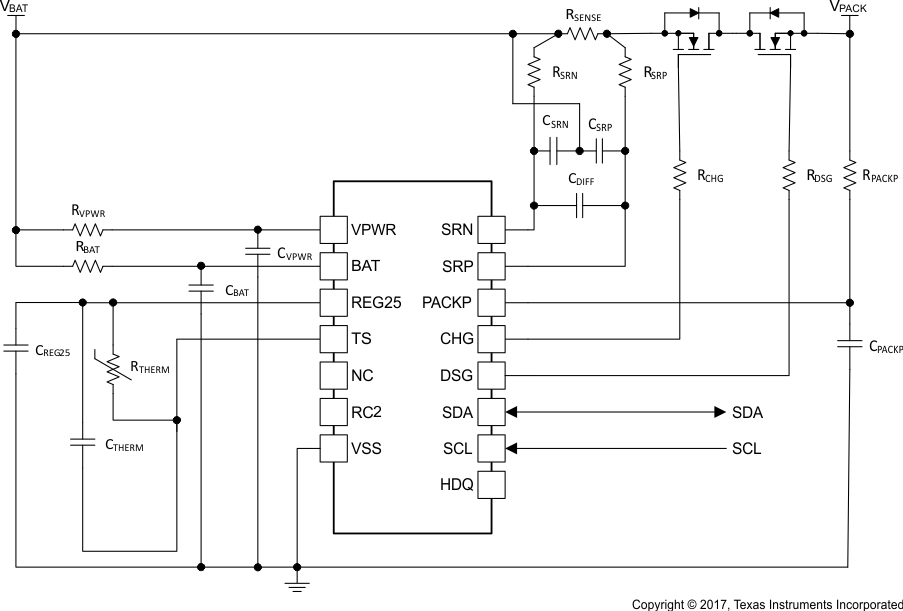SLUSBV9D March 2014 – January 2018
PRODUCTION DATA.
- 1 Features
- 2 Applications
- 3 Description
- 4 Revision History
- 5 Pin Configuration and Functions
-
6 Specifications
- 6.1 Absolute Maximum Ratings
- 6.2 ESD Ratings
- 6.3 Recommended Operating Conditions
- 6.4 Thermal Information
- 6.5 Power-On Reset
- 6.6 2.5-V LDO Regulator
- 6.7 Charger Attachment and Removal Detection
- 6.8 CHG and DSG FET Drive
- 6.9 Overvoltage Protection (OVP)
- 6.10 Undervoltage Protection (UVP)
- 6.11 Overcurrent in Discharge (OCD)
- 6.12 Overcurrent in Charge (OCC)
- 6.13 Short-Circuit in Discharge (SCD)
- 6.14 Low Voltage Charging
- 6.15 Internal Temperature Sensor Characteristics
- 6.16 High-Frequency Oscillator
- 6.17 Low-Frequency Oscillator
- 6.18 Integrating ADC (Coulomb Counter) Characteristics
- 6.19 ADC (Temperature and Cell Voltage) Characteristics
- 6.20 Data Flash Memory Characteristics
- 6.21 Timing Requirements
- 6.22 Typical Characteristics
-
7 Detailed Description
- 7.1 Overview
- 7.2 Functional Block Diagram
- 7.3 Feature Description
- 7.4 Device Functional Modes
- 7.5 Battery Parameter Measurements
- 7.6 Communications
- 7.7 Standard Data Commands
- 7.8 Extended Data Commands
-
8 Application and Implementation
- 8.1 Application Information
- 8.2
Typical Applications
- 8.2.1 Pack-Side, Single-Cell Li-Ion Fuel Gauge and Protector
- 8.2.2 Design Requirements
- 8.2.3
Detailed Design Procedure
- 8.2.3.1 BAT Voltage Sense Input
- 8.2.3.2 SRP and SRN Current Sense Inputs
- 8.2.3.3 Sense Resistor Selection
- 8.2.3.4 TS Temperature Sense Input
- 8.2.3.5 Thermistor Selection
- 8.2.3.6 VPWR Power Supply Input Filtering
- 8.2.3.7 REG25 LDO Output Filtering
- 8.2.3.8 Communication Interface Lines
- 8.2.3.9 PACKP Voltage Sense Input
- 8.2.3.10 CHG and DSG Charge Pump Voltage Outputs
- 8.2.3.11 NFET Selection
- 8.2.3.12 Additional ESD Protection Components
- 8.2.4 Application Curves
- 9 Power Supply Recommendation
- 10Layout
- 11Device and Documentation Support
- 12Mechanical, Packaging, and Orderable Information
Package Options
Mechanical Data (Package|Pins)
- YZF|15
Thermal pad, mechanical data (Package|Pins)
Orderable Information
3 Description
The Texas Instruments bq27742-G1 is a fuel gauge for single-cell Li-Ion battery packs that uses patented Impedance Track™ technology to deliver rate-, temperature-, and aging-compensated predictions of remaining battery capacity and system runtime with highest accuracy. The device also includes a fully integrated high-side protector that eliminates the need for a separate Li-Ion protection circuit and provides a full suite of high-accuracy fault detections for overvoltage, undervoltage, overcurrent in charge, overcurrent in discharge, and short-circuit in discharge conditions. The hardware protection functions offer built-in data flash-based programmability, allowing simple reconfiguration of existing devices for varying end equipment needs.
The fuel gauge provides information such as remaining battery capacity (mAh), state-of-charge (%), runtime to empty (minutes), voltage (mV), current (mA), and temperature (°C), as well as recording vital parameters throughout the lifetime of the battery. The device also supports interrupts to the host to indicate detection of a variety of important battery conditions to the system.
The DSBGA is a 15-ball package (2.78 mm × 1.96 mm) that is ideal for space-constrained applications.
Device Information(1)
| PART NUMBER | PACKAGE | BODY SIZE (NOM) |
|---|---|---|
| BQ27742YZFR-G1 | YZF (15) | 2.78 mm × 1.96 mm |
| BQ27742YZFT-G1 |
- For all available packages, see the orderable addendum at the end of the data sheet.
Simplified Schematic
